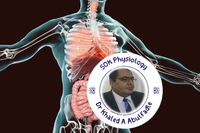admin
Admin

عدد المساهمات : 9696
تاريخ التسجيل : 06/08/2009
 |  موضوع: Common SEQs on all physiology of 2nd year medical students by Dr Khaled Abulfadle موضوع: Common SEQs on all physiology of 2nd year medical students by Dr Khaled Abulfadle  الأربعاء أبريل 28, 2010 11:31 am الأربعاء أبريل 28, 2010 11:31 am | |
|
عدل سابقا من قبل Admin في الأربعاء يناير 04, 2017 7:30 pm عدل 1 مرات | |
|
admin
Admin

عدد المساهمات : 9696
تاريخ التسجيل : 06/08/2009
 |  موضوع: امثله لموضوعات مهمه موضوع: امثله لموضوعات مهمه  الأحد يونيو 20, 2010 2:49 pm الأحد يونيو 20, 2010 2:49 pm | |
| C.N.S.
Receptor potential
Adaptation of receptors
Types of pain& pathway
Referred pain
Reactions to pain
Pain control system
Types of touch &pathway
Types of proprioceptive &pathway
Sensory leminsci
Types of synaptic potential (inhibition)
Properties of synaptic transmission
Motor tetanus & reflex tetanus
Structure & innervations of muscle spindle
Types & function of stretch reflex
Pyramidal tracts & Extra pyramidal tracts
UMNL&LMNL
Unilateral lesion of internal capsule
Complete transaction of spinal cord
Hemi section of spinal cord
Function of cerebellum & connection
Neocerebellum syndrome
Function of basal ganglia & connection
Parkinsonism & chorea
Function of thalamus & lesions
Function & lesion of Hypothalamus
Results of stimulation of SCC & neural connection
Function & lesion of limbic system
Types of sleep & theories
Types of cells & function of RF
Function and lesion of area (4) and area (6)
Somatic sensory area
Speech and Aphasia
Memory
……………………………………………………………
Endocrine
Function and regulation of ADH
Function and regulation of Oxytocin
Function and regulation of adenohypophysial hormone
Function and regulation of Prolactin
Hypopitutarism and hyperpituitarism
Hyperprolactinemia
Function and regulation of catecholamines
Function and regulation of thyroid hormone
Hypothyrodism and hyper thyrodism
Function and regulation of parathyroid hormones
Ca+2 regulations
Disorder of parathyroid
Function and regulation of Aldosterone
Function and regulation of cortisol
Disorder of adrenal cortex
Function and regulation of Insulin
Function and regulation of glucagon
D.M
Regulation of glucose
Adrenomedullin
……………………………………………………………
Reproduction
Factors affecting spermatogenesis ( Sretoli cells )
Endocrine function of testis
Control and abnormalities of testicular function
Semen
Ovulation (indicators )
Ovarian hormones
Uterine cycle
Function of placenta
Parturition ( labor )
Puberty and menopause
…………………………………………………………....
Kidney
JGA
Factors controlling RBF
Factors controlling GRF
Renal handling of Na and factors affecting
Renal handling of K and factors affecting
Renal handling of Ca and phosphate
Renal handling of glucose and factors affecting
Renal handling urea
Renal handling of water and auto regulation
Counter current mechanism
Diuretics
Control of ECF volume and osmolarity
Renal regulation of pH
Micturation and abnormalities
Renal failure ( chronic)
Dehydration and over hydration
Acidosis and alkalosis
Na & K disturbance
………………………………………………………….
Special senses
Structure and causes of cornea transparency
Aqueous & IOP& Glaucoma
Structure and causes of lens transparency
Function of iris
Errors of refraction
Duplicity theory
Photo receptor potential
Retinal adaptation
Color vision and color blindness
After image phenomenon
Binocular vision
Visual pathway ( cortex ) and lesion
Function of external ear
Function of middle ear
Electrical response in choclea
Mechanism of hearing
Discrimination of sound
Auditory pathway
Mechanism of olfaction and pathway
Taste modalities and mechanism
……………………………………………………………
G.I.T
Control of salivary secretion
Swallowing
HCl
Gastrin H.
Control of gastrin secretion
Vomiting
Motility of small intestine
Exocrine pancreatic secretion
Function of large intestine
Defecation
Jaundice
Function & regulation of bile salts & gall bladder
GIT absorption
……………………………………………………………
Metabolism
R.Q
B.M.R ( factors affecting )
S.D.A
Metabolic system in exercise & ME & O2 debt
Regulation of food intake
Obesity
Effect of starvation ( protein metabolism )
Effect of exposure to cold and heat
Disorder of temperature regulation | |
|
